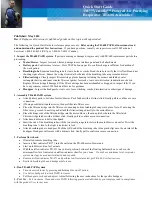
Safety Precautions
16
Welding Precautions
Take precautions before electrically welding any
portion of the unit or the vehicle to which it is
attached. Ensure that welding currents are not
allowed to flow through the unit’s electronic
circuits.
Observe the following precautions when welding
to avoid damaging electronic components.
•
If the microprocessor has a power switch, turn
it OFF before connecting or disconnecting the
battery.
•
Disconnect power to the unit.
•
Disconnect all wire harnesses from the
microprocessor.
•
If there are any electrical circuit breakers in
the control box, switch them OFF.
•
Close the control box.
•
Components that could be damaged by
welding sparks should be removed from the
unit.
•
Use normal welding procedures, but keep the
ground return electrode as close to the area
being welded as practical. This will reduce the
likelihood of stray welding currents passing
through any electronic circuits.
First Aid
First Aid, Refrigerant
In the event of frostbite, protect the frozen area
from further injury, warm the area rapidly and
maintain respiration.
EYES :
For contact with liquid, immediately flush
eyes with large amounts of water. CALL A
PHYSICIAN.
SKIN:
Flush area with large amounts of warm
water. Do not apply heat. Remove contaminated
clothing and shoes. Wrap burns with dry, sterile,
bulky dressing to protect from infection. CALL A
PHYSICIAN. Wash contaminated clothing before
reuse.
INHALATION:
Move victim to fresh air and use
CPR (cardio pulmonary resuscitation) or
mouth-to-mouth resuscitation to restore breathing,
if necessary. Stay with victim until emergency
personnel arrive.
First Aid, Refrigerant Oil
EYES :
Immediately flush with water for at least
15 minutes. CALL A PHYSICIAN. Wash skin
with soap and water.
INGESTION:
Do not induce vomiting.
Immediately contact local poison control center or
physician.
First Aid, Engine Coolant
EYES :
Immediately flush with water for at least
15 minutes. CALL A PHYSICIAN. Wash skin
with soap and water.
INGESTION:
Do not induce vomiting.
Immediately contact local poison control center or
physician.
First Aid, Electrical Shock
Take IMMEDIATE action after a person has
received an electrical shock. Get quick medical
assistance, if possible.
The source of the shock must be quickly stopped,
by either shutting off the power or removing the
victim. If the power cannot be shut off, the wire
should be cut with an non-conductive tool, such as
a wood-handle axe or thickly insulated cable
cutters. Rescuers should wear insulated gloves
and safety glasses, and avoid looking at wires
being cut. The ensuing flash can cause burns and
blindness.
If the victim must be removed from a live circuit,
pull the victim away with a non-conductive
material. Use wood, rope, a belt or coat to pull or
push the victim away from the current. DO NOT
TOUCH the victim. You will receive a shock from
current flowing through the victim’s body. After
separating the victim from power source,
immediately check for signs of a pulse and
respiration. If no pulse is present, start CPR
(cardio pulmonary resuscitation). If a pulse is
present, respiration might be restored by using
mouth-to-mouth resuscitation. Call for emergency
medical assistance.
Summary of Contents for SB-210
Page 4: ...4 ...
Page 12: ...List of Figures 12 ...
Page 31: ...Unit Description 31 Unit Photos Figure 6 Front View AJA1617 ...
Page 36: ...Unit Description 36 ...
Page 49: ...Operating Instructions 49 Figure 32 Viewing Sensors Screen Sequence ...
Page 54: ...Operating Instructions 54 Figure 40 Datalogger Screen Sequence ...
Page 101: ...Engine Maintenance 101 ...
Page 102: ...Engine Maintenance 102 ...
Page 140: ...Electric Standby Diagnosis 140 ...
Page 150: ...Index 150 ...
Page 152: ...Wiring Diagram Index 152 ...
Page 153: ...153 Model 30 and 50 Schematic Diagram Page 1 of 3 ...
Page 154: ...154 Model 30 and 50 Schematic Diagram Page 2 of 3 ...
Page 155: ...155 Model 30 and 50 Schematic Diagram Page 3of 3 ...
Page 156: ...156 Model 30 and 50 Wiring Diagram Page 1 of 4 ...
Page 157: ...157 Model 30 and 50 Wiring Diagram Page 2 of 4 ...
Page 158: ...158 Model 30 and 50 Wiring Diagram Page 3 of 4 ...
Page 159: ...159 Model 30 and 50 Wiring Diagram Page 4 of 4 ...
















































